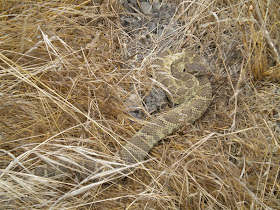
Rattlesnake babies develop within little sacs in the mom's oviducts, seeing as how snakes do not have a uterus. Inside these sacs are the baby and a yolk sac, which are connected by an umbilical cord. A wee different from mammals, and perhaps even more cool.

Here's a female early in the morning on the way out of her rodent hole.

This female is stretched out in the grass, showing how hard the snakes can be to see at times.
Viviparity in reptiles is associated with interesting behaviors. Last week I was privileged to witness these behaviors in our local Northern Pacific rattlesnakes (Crotalus oreganus) at Montana de Oro State Park. A citizen herper called me up and invited me down to check out some snakes he has been watching all year. As we walked along a trail frequented by hikers, he pointed out a total of 12 rattlesnakes resting in loose coils on top of matted grasses. None of the passing hikers so much as noticed the serpents' presence. Probably a good thing, as noticed rattlesnakes often end up dead. Of the 12 snakes, two were males, one was a non-reproductive female, and nine were pregnant females. All photos are taken in situ, which is why the snakes are hard to see.
This guy is literally sitting right on the edge of the trail. We saw a bunch of people walk right past him.

And here are the prego girls. There are at least two reasons we saw so many pregnant snakes. First, we had lots of rain this spring, which intuitively means lots of primary production, which means lots of rodents, which means lots of snake food, which means lots of extra energy to make babies out of. Indeed, we witnessed tremendous mating activity this spring. Second, we likely saw more pregnant females out than non-reproductive snakes because the viviparous pregnant females need to sit on the surface to thermoregulate. I like to call this "cookin' babies."
Here's a female early in the morning on the way out of her rodent hole.

This female is stretched out in the grass, showing how hard the snakes can be to see at times.

Here's a female sitting next to a shed skin that is clearly too large to be hers. There must be so many other snakes hiding nearby!

Sometimes the pregnant females hang out in groups, in which case the location of the gathering is called a rookery. We found these two girls together, and my guide explained that there are often two others with them.

I am intrigued by this population of snakes, which lives in an environment so dramatically different from those we study inland. Here at the beach it is relatively cool year round, and importantly does not get very cold in winter. At our inland site, it gets incredibly hot in the summer and cold in the winter. There is a smorgasbord of small rodents here at the beach, and the snakes are somewhat small. Inland, the males are huge because they can grab ground squirrels and rabbits. Here at the beach (they are literally living just a few meters from the surf) the snakes probably experience an increased salt load relative to the inland population. How do their predators differ? Inland there seem to be more snake-munching badgers and birds of prey, like this redtail hawk parent feeding its baby:


(I got the amazing hawk photos here, and the photographer is not identified.)
Thank you to Dave for showing me these amazing beasties! I can't wait to see all the snake baby biomass that will result. Any day now!




No comments:
Post a Comment